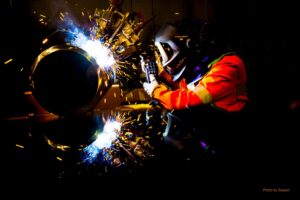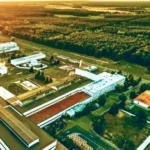During the POWERPOL conference a panel „Gas in Poland’s energy policy” was held. Market participants tried to answer questions concerning prospects of gas production and import into Poland, directions of changes, and key investment projects. Speakers agreed that the volatility of the gas market, prices, new sources and infrastructure will determine the future of diversification. The conference was organized under the patronage of BiznesAlert.pl.
„The Mandatory Stock Act does not prevent liberalisation”
Henryk Mucha, CEO of PGNiG Retail Trading, summing up the period 2014-2017, emphasized that in 2015 the gas market and its liberalization were developing. – We started to implement the strategy as the Group. In 2016 it was an erosion of the customer base. The first step was to improve the price offer. PGNIG lost its monopoly at that time and is no longer a monopolist. The market is liberalising in spite of the gas stock act, contrary to announced projections. It is becoming increasingly attractive and the number of offers is increasing. The companies compete with each other. These are benefits for the customer. Liberalisation is a process that will develop – he said.
Henryk Młodawski, Member of Exalo Drilling’s Management Board, stressed that deposits were present in Poland. He said that of the 30 wells drilled this year, 80 percent of them were confirmed to be oil and gas wells and half of them would be commercially exploited. He gave an example of drillings in Norway that were drilled in the 1970s, are currently in use, and will continue to be used for years to come. – This is the effect of technology. If we returned to the old boreholes, then we would have a chance to extract the raw material. Large deposits of oil and gas can be found in the so-called Deep Carpathians, also on the other side of the border. Technology is not the limit, the limit is our own determination and counting how much money we have – he emphasized. When asked about the level of production in 2030, he said that gas from coal deposits can increase it by at least 1 billion cubic metres.
Dr. Adam Węgrzyn, Member of the Management Board of the Polish Gas Company, said that the company with its new strategy had taken on the burden of being a national gas distributor in Poland. – Where there is a gas network, regions are more likely to develop. The need to build gas pipelines generates high costs, which is why we are looking for other methods of connecting to gas. The opportunity lies in LNG-based gasification, where it is not possible to build a line network. LNG also allows repair works to be carried out. Local LNG stations can also relieve the burden on transmission networks when there is too much demand. Additionally, the Electromobility Act requires PSG to build CNG stations. We are also planning to build several new LNG facilities, among others in Jarosław – as he informed.
We will all pay for Baltic Pipe, but it is supposed to pay off with lower gas prices
Wojciech Jakóbik, editor-in-chief of BiznesAlert.pl, when asked about how gas prices will change after the Baltic Pipe gas pipeline is launched, said that the figures were already known from Open Season, where PGNiG was the only one to reserve more than 8 billion cubic metres of the capacity planned for 10 billion cubic metres. – It is possible that Lotos or Statoil will join gas transmission from Norway, after PGNiG. PGNiG wants to produce up to 2.5 billion cubic metres of gas in Norway by 2025. Will prices be lower? We will see. It is worth remembering that there will probably be no longer a contract like the Yamal contract, for a few years and with rigid clauses. It will be interesting to list oil-indexed contracts against those that depend on stock market prices, but in the future companies will move away from that. The expansion of the LNG terminal and its benefits will also be significant. An example is the purchase of LNG from the United States from the British Centrica, where, according to the Polish authorities, the price was indexed to the stock exchange and not to oil prices – he said.
Piotr Kasprzak – Member of the Management Board for Operational Affairs of Hermes Energy Group S. A. stated that in principle the retail market in Poland was functioning. – As far as the gas price compared to the Gaz System tariff is concerned, the construction cost of the Baltic Pipe will be incurred, so we will all pay for this investment. Additionally, as market participants, we will pay more due to the Mandatory Stock Law. Security of supply and diversification should be the objective, but prices for the end-customer should also be important. For me, as a participant, the higher the price, the better – he said.
Dr Andrzej Sikora from the Institute of Energy Studies stated that Nord Stream 2 would be the most important investment from the point of view of the Polish market. – Another factor determining the situation is the lack of an energy and raw material strategy, and the latter is expected to be available no earlier than in two years’ time. Energy policy can be a remedial factor in the fight against Nord Stream 2. We do not know how much gas we will need – he said. Another element is excess LNG on the market. He wondered why Poland is investing in declining deposits in Norway. – And why are we not in the USA? – He asked. He stressed the importance of the extension and connection of the terminal in Świnoujście. He added that LNG from the USA could flow mainly to Asia and not to Europe. Methane hydrates can be a revolution in gas. In the context of gas supplies from the Centrica to PGNiG, he said that gas was a commodity as any other commodity. – It is possible that the British who are leaving the EU will offer us gas from Russia – he added.
A gas hub as a historical necessity
Dawid Klimczak, CEO of ENEA Trading, said that the volume is the most important for the trader. – Much is happening in infrastructure, the number of concessions is increasing – there are currently two hundred of them. 138 TWh traded on the gas exchange is 40 percent more than on the electricity market. In 2017, the volume of LNG on the market doubled. It is also increasing with gas transmission to Ukraine. Price volatility is also visible on TGE in the scope of gas, i. e. from about ten to several zlotys. Traders are able to generate more profit – he said.
Marcin Sienkiewicz from the Polish Power Exchange (TGE) pointed out that the sum of events indicated that it would be possible to look into the future with optimism. – There is a growing awareness among customers that it is possible to change suppliers and the offer may be richer. This is an opportunity for a market game. Another impulse is the infrastructure (such as the Northern Gateway) which will allow diversification and variability of contract forms. The sum of all this shows that space is being created for a new volume of gas. Trends in the power industry show signals from companies – new sources will be gas-based – he said. He added that the construction of a gas hub was part of the Responsible Development Strategy. – There are chances for its creation, and this is also a historical necessity – he added.
Wojciech Jakóbik added that it was worth looking at Baltic Pipe in business terms. – Operators from Denmark and Norway were not supposed to be on board – and yet they were; Open Season was not supposed to happen, but it already has – he said. In his view, the same is true for LNG supplies and he believes that data from the International Energy Agency should be taken into account. – In Poland there was to be no liquefied gas from the United States. And yet there is. It was supposed to be uncompetitive, but the authorities informed about a contract indexed to European prices, which is to be competitive. Of course, we do not know the terms of the contracts. Meanwhile, according to the Agency, in 2025 the USA will be able to export around 40 billion cubic metres per year to Europe. Maybe 3-5 billion cubic meters can be cut out of it for Poland. The PGNiG agreement with Centrica shows that this is feasible. It also shows that we should break with the myth that LNG from the USA is too expensive – said Jakóbik.








